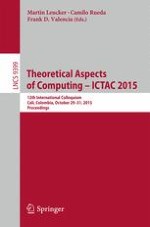2015 | Buch
Theoretical Aspects of Computing - ICTAC 2015
12th International Colloquium, Cali, Colombia, October 29-31, 2015, Proceedings
herausgegeben von: Martin Leucker, Camilo Rueda, Frank D. Valencia
Verlag: Springer International Publishing
Buchreihe : Lecture Notes in Computer Science
